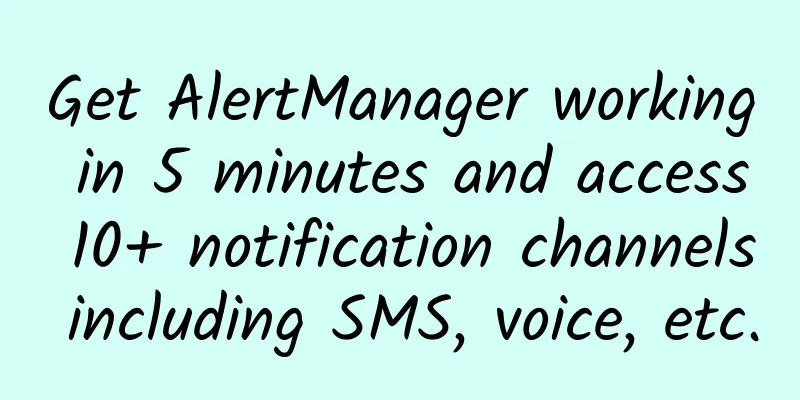Get AlertManager working in 5 minutes and access 10+ notification channels including SMS, voice, etc.

|
SLS Alarm Management As a member of the Prometheus ecosystem, AlertManager provides a variety of alarm management services including silencing, suppression, and notification. At the same time, AlertManager still has more or less shortcomings in actual use, such as too few notification channels and cumbersome rule configuration process. In order to solve the problems of alarm notification and management, Alibaba Cloud Log Service launched the Log Service Alarm Center, providing customers with a one-stop alarm solution. The following figure shows the functional comparison between SLS alarm and AlertManager+Prometheus ecosystem. It can be seen that SLS alarm provides enterprise-level services, which can greatly facilitate users' work. SLS open alarm The open alarm function provided by SLS Alarm can easily connect the alarm messages of third-party systems to the SLS Alarm Center without any modification to the existing system. The alarm message flow after AlertManager is connected to SLS Alarm is shown in the figure below: The following describes the detailed process of connecting AlertManager to SLS alarm, including SLS alarm configuration and AlertManager configuration. SLS alarm configuration 1. Create an action strategy The action strategy will determine how and through what channels SLS will notify you after receiving an alert message from Alert Manager. To do this, you need to first open the Alert Center, click Alert Management, and select an action strategy in the drop-down menu: Then click the Add button in the upper left corner of the page, configure a new action strategy in the pop-up dialog box, and then click Confirm . Currently, the system supports notification channels such as voice, SMS, email, DingTalk, and WeChat for Enterprise. For specific configuration methods of action strategies, please refer to the official document Creating Action Strategies. 2. Create an open alert service First, open the Alarm Center, click Alarm Management , and select Open Alarm in the drop-down menu: Click the Create button in the upper left corner of the page, configure the new open alarm service in the pop-up dialog box, including the service ID and service name, and then click Save : 3. Create an open alarm application Select the service created in the previous step and click the Apply button for the service in the Action column: In the pop-up dialog box, click Create , add a new application, and click Save . Select AlertManager for the protocol, the strategy configured in the first step for the action strategy, and the default values for the remaining options. 4. Obtain the open alarm application interface Now, a new alarm application already exists in the open alarm service you created in step 2. Click the interface button in the operation bar of the application to obtain the interface information: The interface address consists of two parts: Domain name part: The access address of SLS, which is related to the region. Each region has its own access address. Alert Manager Access Configuration In the Alert Manager configuration file, you first need to create a receiver for the alert message. To do this, you need to add a Webhook receiver under the receivers configuration item and fill in the interface address obtained in the previous step in the url field. Then, you need to add the previously created receiver under the route configuration item. A typical configuration file is shown below: route: receiver: '{RECIEVER_NAME}' ... ... receivers: - name: '{RECIEVER_NAME}' webhook_configs: - url:
- name: ... {RECIVER_NAME} is the name customized by the user for the recipient. Effect display View alarm messages In the transaction view interface of the alarm center, you can view the list of received alarm messages and the details of the alarm message. Alarm Access Overview In the open alarm dashboard , you can view the filtering and sending status of alarm messages. Alarm Notification Overview The alert dashboard shows an overview of all alert messages, and you can view the volume of messages sent through different notification channels. |
<<: The slowdown in 5G construction is not a problem, 5G application is the key
>>: Why 5G won’t replace Wi-Fi 6 at the edge anytime soon
Recommend
Five-minute technical talk | Understand how computers send and receive information in one article
Part 01 Physical Layer If a computer wants to tra...
The Experience Economy is in Full Swing: Aruba Drives the Intelligent Digital Workplace
Under the wave of mobility and digitalization, th...
How many of the 7 core technologies that operate blockchain do you know?
1. Blockchain Links As the name implies, blockcha...
5G Era Series: Battle of Big Companies
[[395527]] Nearly two years have passed since the...
How 5G will impact IoT technology
According to many predictions, the Internet of Th...
RAKsmart: US/Hong Kong/Japan VPS starting from $1.99 per month, G-port unlimited traffic server starting from $199 per month
RAKsmart is an early-established foreign hosting ...
LOCVPS 20% off: 29.6 yuan/month - 1GB/30GB/400GB@100Mbps/Osaka, Japan
LOCVPS is a domestic hosting company founded in 2...
Ruijie Networks releases its wireless product strategy of “Vast New Connections”
On June 5, Ruijie Networks held a "Vast New ...
Edge chips could render some networks useless
【51CTO.com Quick Translation】Some scientists say ...
AlphaVPS: 128GB-2TB large hard disk VPS annual payment starts from 15 euros
AlphaVPS is a Bulgarian hosting company registere...
Wi-Fi 7: What is it and when can you expect it to arrive?
[[380191]] Wi-Fi 7 is expected to have higher dat...
Just remember one number and you can quickly calculate the available range of the IP segment.
As long as you remember a simple number, you can ...
Remember 3 parts, 2 addresses, and 1 formula, and you can easily divide subnets
Overview Subnetting is a basic skill that any net...
Yahoo's valuation dropped from $4.8 billion to $350 million, 32 million accounts leaked due to "cookie forgery"
[51CTO.com original article] Yahoo's latest n...
F5 Cloud Native Keywords: Transformation, Construction, Integration
[51CTO.com original article] Cloud native is one ...









